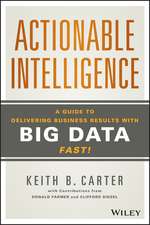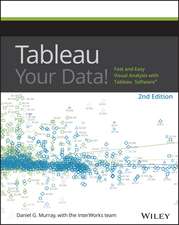Agile Information Systems
Autor Kevin Desouzaen Limba Engleză Paperback – 30 aug 2006
• have the ability to add, remove, modify, or extend functionalities with minimal penalties in terms of time, cost, and effort
• have the ability to process information in a flexible manner
• have the ability to accommodate and adjust to the changing needs of the end-users.
This is the first book to bring together academic experts, researchers, and practitioners to discuss how companies can create and deploy agile information systems. Contributors are well-regarded academics known to be on the cutting-edge of their fields.
The Editor, Kevin Desouza, has organized the chapters under three categories:
• discussion of the concept of agile information systems (i.e. defining agile information management, its attributes, antecedents, consequences, etc.)
• discussion of information systems within the context of agility (i.e., descriptions of agile information systems and their attributes, how to build agile information systems, etc.)
• discussion of organizational management issues in the context of agile information systems (i.e., how to prepare the organization for agile information systems, management of agile information systems for improved organizational performance, etc.)
| Toate formatele și edițiile | Preț | Express |
|---|---|---|
| Paperback (1) | 263.45 lei 5-7 săpt. | |
| Taylor & Francis – 30 aug 2006 | 263.45 lei 5-7 săpt. | |
| Hardback (1) | 875.55 lei 6-8 săpt. | |
| Taylor & Francis – 26 apr 2017 | 875.55 lei 6-8 săpt. |
Preț: 263.45 lei
Preț vechi: 418.48 lei
-37% Nou
Puncte Express: 395
Preț estimativ în valută:
50.41€ • 52.01$ • 42.07£
50.41€ • 52.01$ • 42.07£
Carte tipărită la comandă
Livrare economică 20 martie-03 aprilie
Preluare comenzi: 021 569.72.76
Specificații
ISBN-13: 9780750682350
ISBN-10: 0750682353
Pagini: 322
Ilustrații: Illustrated
Dimensiuni: 152 x 229 x 18 mm
Greutate: 0.6 kg
Ediția:1
Editura: Taylor & Francis
Colecția Routledge
Locul publicării:Oxford, United Kingdom
ISBN-10: 0750682353
Pagini: 322
Ilustrații: Illustrated
Dimensiuni: 152 x 229 x 18 mm
Greutate: 0.6 kg
Ediția:1
Editura: Taylor & Francis
Colecția Routledge
Locul publicării:Oxford, United Kingdom
Public țintă
Primary audience: Academics and Practitioners in Information Systems Management.Cuprins
Strategizing for agility, Robert D. Galliers; Agile information systems for agile decision making, William B. Rouse; The logic of knowledge, William E. Halal, Producing and consuming agility, Anders Mårtensson; Business agility, Marcel van Oosterhout et al., Achieving economic returns from IS support for strategic flexibility, Michael J. Zhang; Balancing stability and flexibility: The case of the California Energy Commission, Miguel Gabriel Custodio et al., Enabling strategic agility through agile information systems, John G Mooney and Dale Ganley, Agile information systems as a double dream, Silvia Gherardi and Andrea Silli, Degrees of agility, Tsz-Wai Lui and Gabriele Piccoli, Integration management for heterogeneous Information Systems, Joachim Schelp and Robert Winter; Investigating the role of information systems in contributing to the agility of modern supply chains, Adrian E. Coronado M. and Andrew C. Lyons; Clumsy Information Systems, Sue Newell, et al., Enterprise information systems and the preservation of agility, Anthony Wensley and Eveline van Stijn; Interpretative flexibility and hosted ERP systems, Sarah Cadili and Edgar A. Whitley; Agile drivers, capabilities and value, Kieran Conboy and Brian Fitzgerald; Vigilant information systems: The Western digital experience, Bob Houghton et al., Coors Brewing point of sale application suite: An agile development project, Jack Buffington and Donald J. McCubbrey; Organizational agility with mobile ICT? The case of London Black Cab Work, Silvia Elaluf-Calderwood and Carsten Sørense; Co-evolution and Co-design of agile organizations and information systems through agent-based modeling, Mark E. Nissen and Yan Jin
Descriere
This book presents cutting-edge research and thinking on agile information systems. The concept of agile information systems has gained strength over the last 3 years, coming into the MIS world from manufacturing, where agile manufacturing systems has been an important concept for several years now. The idea of agility is powerful: with competition so fierce today and the speed of business so fast, a company’s ability to move with their customers and support constant changing business needs is more important than ever. Agile information systems:
• have the ability to add, remove, modify, or extend functionalities with minimal penalties in terms of time, cost, and effort
• have the ability to process information in a flexible manner
• have the ability to accommodate and adjust to the changing needs of the end-users.
This is the first book to bring together academic experts, researchers, and practitioners to discuss how companies can create and deploy agile information systems. Contributors are well-regarded academics known to be on the cutting-edge of their fields.
The Editor, Kevin Desouza, has organized the chapters under three categories:
• discussion of the concept of agile information systems (i.e. defining agile information management, its attributes, antecedents, consequences, etc.)
• discussion of information systems within the context of agility (i.e., descriptions of agile information systems and their attributes, how to build agile information systems, etc.)
• discussion of organizational management issues in the context of agile information systems (i.e., how to prepare the organization for agile information systems, management of agile information systems for improved organizational performance, etc.)
• have the ability to add, remove, modify, or extend functionalities with minimal penalties in terms of time, cost, and effort
• have the ability to process information in a flexible manner
• have the ability to accommodate and adjust to the changing needs of the end-users.
This is the first book to bring together academic experts, researchers, and practitioners to discuss how companies can create and deploy agile information systems. Contributors are well-regarded academics known to be on the cutting-edge of their fields.
The Editor, Kevin Desouza, has organized the chapters under three categories:
• discussion of the concept of agile information systems (i.e. defining agile information management, its attributes, antecedents, consequences, etc.)
• discussion of information systems within the context of agility (i.e., descriptions of agile information systems and their attributes, how to build agile information systems, etc.)
• discussion of organizational management issues in the context of agile information systems (i.e., how to prepare the organization for agile information systems, management of agile information systems for improved organizational performance, etc.)













